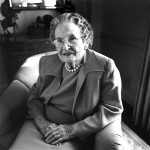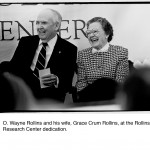
Grace Crum Rollins
She was quiet and small in stature but firm in her beliefs. Grace Crum Rollins made good on her late husband’s promise of helping construct a building to house Emory’s School of Public Health. In 1994, the Grace Crum Rollins Building became the permanent home for the school that Emory named for her extraordinary family.
Mrs. Rollins, whose generosity led the Rollins School of Public Health to become one of the nation’s premier schools in its field, died on August 8 at age 98.
Dean James Curran says, “Essentially, the school would not be what it is today without her family. Our faculty, students, and alumni are part of her legacy.â€
Grace Crum married O. Wayne Rollins during the Depression. They worked hard, lived simply, and never bought anything on credit. When Wayne was hospitalized for an appendectomy, Grace knitted to pay his bill.
Years later, Forbes magazine would count him among the nation’s greatest business leaders. In what is considered one of the first leveraged buyouts, Wayne bought Orkin Exterminating in 1964. The family’s business grew to encompass oil and gas services, security systems, and real estate.
Also in 1964, Wayne and Grace moved to Atlanta with their sons Randall and Gary. The couple became involved at Emory through the Candler School of Theology and Wayne’s role as a university trustee. With a lead gift to the School of Medicine, they enabled construction of the O. Wayne Rollins Research Center, doubling Emory’s laboratory space. Upon learning that the School of Public Health needed a building, Wayne volunteered his support but died unexpectedly in 1991. Less than a year after his death, Grace and her sons fulfilled his promise by contributing $10 million for construction.

Wayne and Grace Rollins attend an Emory event
Other gifts followed, including a $50 million lead gift through the O. Wayne Rollins Foundation for a second public health building. The Claudia Nance Rollins Building, which is named for Wayne’s mother, will open in 2010 and more than double the physical size of the school.
The idea of creating the first public health building appealed to Wayne Rollins’ entrepreneurial spirit. With just 20 faculty and 500 graduates, it was a risky endeavor, Curran says.
“Mrs. Rollins kept that commitment” notes Curran. “Today the school has 200 faculty and more than 5,000 alumni in 90 countries.â€




